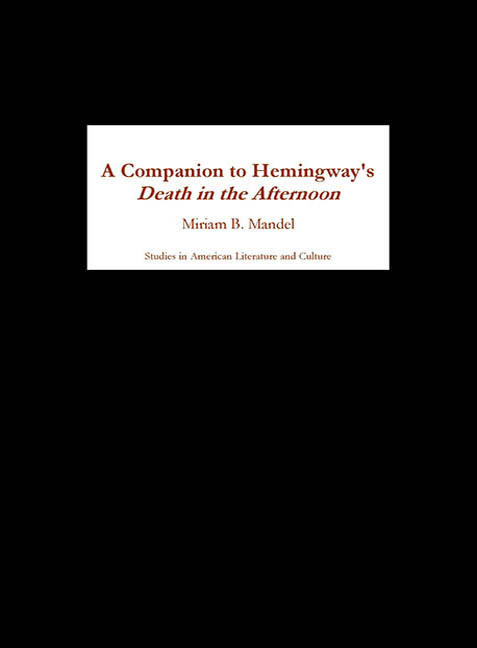Book contents
- Frontmatter
- Dedication
- Contents
- Acknowledgments
- Hemingway Works That Address the Bullfight
- A Note on the Text of Death in the Afternoon
- Introduction
- Composition, Sources, and Backgrounds
- Reading Texts, Paratexts, and Absence
- “The Real Thing–? Representing the Bullfight and Spain in Death in the Afternoon
- “Very Sad but Very Fine”: Death in the Afternoon 's Imagist Interpretation of the Bullfight-Text
- “Far from Simple”: The Published Photographs in Death in the Afternoon
- Deleted “Flashes”: The Unpublished Photographs of Death in the Afternoon
- “¿Qué tal, hombre, qué tal?”: How Paratexts Narrow the Gap between Reader and Text in Death in the Afternoon
- On Authorship and Art
- And What Came After
- Works Cited
- Notes on the Contributors
- Index
“Far from Simple”: The Published Photographs in Death in the Afternoon
from Reading Texts, Paratexts, and Absence
Published online by Cambridge University Press: 27 April 2017
- Frontmatter
- Dedication
- Contents
- Acknowledgments
- Hemingway Works That Address the Bullfight
- A Note on the Text of Death in the Afternoon
- Introduction
- Composition, Sources, and Backgrounds
- Reading Texts, Paratexts, and Absence
- “The Real Thing–? Representing the Bullfight and Spain in Death in the Afternoon
- “Very Sad but Very Fine”: Death in the Afternoon 's Imagist Interpretation of the Bullfight-Text
- “Far from Simple”: The Published Photographs in Death in the Afternoon
- Deleted “Flashes”: The Unpublished Photographs of Death in the Afternoon
- “¿Qué tal, hombre, qué tal?”: How Paratexts Narrow the Gap between Reader and Text in Death in the Afternoon
- On Authorship and Art
- And What Came After
- Works Cited
- Notes on the Contributors
- Index
Summary
I found the definite action; but the bullfight was so far from simple […].
Death in the Afternoon, 3While in principle all subjects are worthy pretexts for exercising the photographic way of seeing, the convention has arisen that photographic seeing is clearest in offbeat […] subject matter[s]. […] Because we are indifferent to them, they best show up the ability of the camera to “see.”
Susan Sontag, 136–37From the beginning, Hemingway linked his writing about bullfighting with photographs. His first published essay on the subject, “Bull Fighting Is Not a Sport — It Is a Tragedy” (Toronto Star Weekly, 20 October 1923) featured three photographs and a drawing. In 1925, writing to his editor, Maxwell Perkins, at Scribner's, he described the project which eventually became Death in the Afternoon as “a sort of Daughty's [sic] Arabia Deserta of the Bull Ring […] a very big book with some wonderful pictures” (qtd. in Bruccoli, 34). Although Perkins made no comment, Hemingway brought up the project again about nine months later: “I will keep the bull fight book going […]. It will have illustrations — drawings and photographs — and I think should have some colored reproductions” (qtd. in Bruccoli, 53) of works by Goya, Manet, Picasso, Juan Gris, Waldo Peirce, Roberto Domingo, Carlos Ruano Llopis, and Ricardo Marín. And he collected photographs: as Robert W. Lewis comments, Hemingway went to Spain “Almost every summer […] not only to see fights but also to gather information and photographs” (31) — about four hundred of them.
Hemingway's insistence on photographs is understandable: he recognized that recent advances in photography would enable him to present his subject more vividly than had previously been possible. Before the end of the nineteenth century, the nature of glass-plate emulsion photography and the short focal-length of the lenses (about fifty millimeters) made it difficult to capture the rapid action of the bullfight. We have, therefore, only a few memorable action shots of the great luminaries who fought at the turn of the century, stars like Manuel García (El Espartero, killed in 1894), Rafael Guerra (Guerrita, retired in 1899), or Luis Mazzantini (retired in 1904). By the 1910s, however, action photography was well developed: the depth of field and sharpness of focus were more precise, and longer focal-length lenses ensured a more reliable result.
- Type
- Chapter
- Information
- A Companion to Hemingway's Death in the Afternoon , pp. 165 - 188Publisher: Boydell & BrewerPrint publication year: 2004



